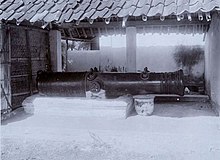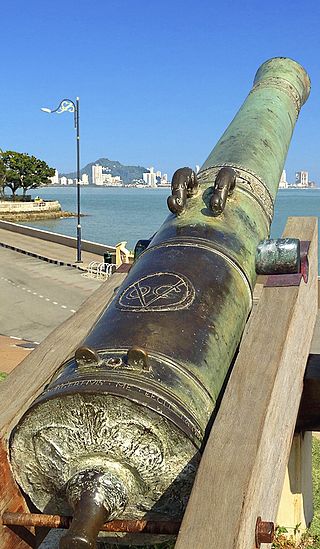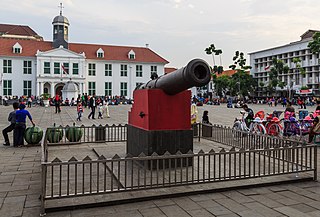
Ki Amuk is an ancient cannon belonging to the Sultanate of Banten, which is currently located in front of the Grand Mosque of Banten, Banten Province, Indonesia. Ki Amuk cannon was used to protect the Karanghantu Port in Banten Bay.

Ki Amuk is an ancient cannon belonging to the Sultanate of Banten, which is currently located in front of the Grand Mosque of Banten, Banten Province, Indonesia. Ki Amuk cannon was used to protect the Karanghantu Port in Banten Bay.
According to legend, Ki Amuk was the incarnation of the cursed Sultanate of Demak soldier. But according to the historical sources, this cannon was made in Central Java in the 16th century around 1527 A.D., which was later presented to Sultan Hasanuddin of the Sultanate of Banten by Sultan Trenggono, originally named Ki Jimat. Si Jagur cannon in the Jakarta Fatahillah Museum yard is the "twin" of Ki Amuk. [1]
The Ki Amuk cannon is made of bronze weighing 7 tons, with the length of 3 m (9.8 ft), the largest outer diameter is 0.70 m (2 ft 4 in), the inside diameter of the mouth is 0.34 m (1 ft 1 in). It fired a cannonball weighing 180 lb (82 kg). [2]
The Majapahit Sun symbol can be seen in its muzzle. There are two Arabic inscriptions on this cannon. The first reads "Aqibah al-Khairi Salamah al-Imani" which means "The fruit of all good is the perfection of faith". The second inscription reads "La fata illa Ali la saifa illa Zu al-faqar, isbir ala ahwaliha la mauta" which means "There is no victor except Ali, there is no sword but Zulfiqar, thou shalt fear God (taqwa) all the time until death". [1]

Banten is the westernmost province on the island of Java, Indonesia. Its capital city is Serang and its largest city is Tangerang. The province borders West Java and the Special Capital Region of Jakarta on the east, the Java Sea on the north, the Indian Ocean on the south, and the Sunda Strait on the west and shares a maritime border with Bengkulu and Lampung to the east and Bangka Belitung Islands to the north. The province covers an area of 9,352.77 km2 (3,611.12 sq mi). It had a population of over 11.9 million in the 2020 census, up from about 10.6 million in 2010. The estimated mid-2023 population was 12.308 million. Formerly part of the province of West Java, Banten was split off to become a province on 17 October 2000.

Old Banten is an archaeological site in the northern coast of Serang Regency, Banten, Indonesia. Located 11 km north of Serang city, the site of Old Banten contains the ruin of the walled port city of Banten, the 16th-century capital of the Sultanate of Banten.

The Kingdom of Pajang or Sultanate of Pajang was a short-lived Muslim state in Java. It was established by Hadiwijaya or Jaka Tingkir, Lord of Boyolali, after a civil war and was a successor to Sultanate of Demak. Hadiwijaya claimed to be a descendant of Brawijaya V, the last king of the Majapahit empire, and Trenggana, the sultan of Demak.
Sunan Kalijaga was one of the "nine saints" of Javanese Islam. The "Kalijaga" title was derived from an orchard known as "Kalijaga" in Cirebon. Other accounts suggest that the name derives from his hobby of submerging himself in Kali. Others note that the name Kalijaga derived its nature from the Arabic notion of qadli dzaqa which means "holy leader" in the sultanate.

The Banten Sultanate was a Bantenese Islamic trading kingdom founded in the 16th century and centred in Banten, a port city on the northwest coast of Java; the contemporary English name of both was Bantam. It is said to have been founded by Sunan Gunungjati, who had previously founded Cirebon.

The history of the arrival of Islam in Indonesia is somewhat unclear. One theory states that Islam arrived directly from Arabia as early as the 9th century, during the time of the Umayyad and Abbasid caliphates. Another theory credits Sufi travelers for bringing Islam in the 12th or 13th century, either from Gujarat in India or from Persia. Before the archipelago's conversion to Islam, the predominant religions in Indonesia were Hinduism and Buddhism.
The Demak Sultanate was a Javanese Muslim state located on Java's north coast in Indonesia, at the site of the present-day city of Demak. A port fief to the Hindu-Buddhist Majapahit kingdom thought to have been founded in the last quarter of the 15th century, it was influenced by Islam brought by Muslim traders from China, Gujarat, Arabia and also Islamic kingdoms in the region, such as Samudra Pasai, Malacca and Bani (Muslim) Champa. The sultanate was the first Muslim state in Java, and once dominated most of the northern coast of Java and southern Sumatra.

Kingdoms of Sunda refers to the monarchies of the Sundanese region prior to the establishment of Indonesia in 1945 AD. The history includes several eras:

The Sunda Kingdom was a Sundanese Hindu kingdom located in the western portion of the island of Java from 669 to around 1579, covering the area of present-day Banten, Jakarta, West Java, and the western part of Central Java. The capital of the Sunda Kingdom moved several times during its history, shifting between the Galuh (Kawali) area in the east and Pakuan Pajajaran in the west.

The Sultanate of Cirebon was an Islamic sultanate in West Java founded in the 15th century. It is said to have been founded by Sunan Gunungjati, as marked by his letter proclaiming Cirebon's independence from Pajajaran in 1482, although the settlement and the polity had been established earlier, in 1445. Sunan Gunungjati also established the Sultanate of Banten. It was one of the earliest Islamic states established in Java, along with the Sultanate of Demak.

Kalinyamat Sultanate or Kalinyamat Kingdom, was a 16th-century Javanese Islamic polity in the northern part of the island of Java, centred in modern-day Jepara, Central Java, Indonesia.
Raden Patah, also known as Jin Bun was the first sultan of the Demak Sultanate. Ascending to the throne in 1475, his remained a vassal of the Majapahit Empire until 1478. Raden Patah took the title Panembahan Jimbun after legitimizing the Sultanate of Demak as the successor state to the Majapahit Empire, with Wali Sanga appointing him as the Sultan of Demak.

The Seri Rambai is a seventeenth-century Dutch cannon displayed at Fort Cornwallis in George Town, the capital city of the Malaysian state of Penang and a UNESCO World Heritage Site. It is the largest bronze gun in Malaysia, a fertility symbol and the subject of legends and prophecy.
The Mataram conquest of Surabaya or Mataram-Surabaya War was a military campaign by the Sultanate of Mataram in the early 17th century that resulted in the capture of the Duchy of Surabaya and its allies in eastern Java, in modern-day Indonesia. Prior to this conquest, Mataram and Surabaya were rivals for power in central and eastern Java. The campaign began in 1614 when Mataram, under the leadership of Sultan Agung, attacked Surabaya's allies, including Wirasaba. Surabaya and its allies launched a counterattack but were defeated near Pajang in 1616. Over the next few years, Mataram gradually conquered members of the Surabayan alliance, and by 1620, the city of Surabaya itself was under siege, holding out until it surrendered in 1625. With this conquest, Mataram unified most of central and eastern Java under its control, and cemented its position as the dominant power in Java. Surabaya and other conquered areas would remain in Mataram's hands until it was ceded to the Dutch East India Company in 1743.

The Kraton Kacirebonan is the oldest Kraton in the Indonesian city of Cirebon. It has existed since 1807. This colonial building has housed many historical relics such as Keris, Wayang puppets, war equipment, Gamelan instruments, and others. Kacirebonan is in the area of the District Pulasaren Pekalipan village, exactly 1 kilometer southwest of Kasepuhan Palace and approximately 500 meters south of Keraton Kanoman. Kraton Kacirebonan is positioned from north to south with a land area of about 46,500 square meters.

The Palembang pitis was a currency issued by the Palembang Sultanate from the 1600s until 1825 when the sultanate was dissolved and its territory taken over by the colonial government of the Dutch East Indies. The currency consisted of low denomination tin alloy coins which were mostly traded in bulk. Due to the lack of a centralized mint, the pitis often had inconsistent manufacture and were frequently counterfeited.

Si Jagur or Ki Jagur is an old cannon of Portuguese heritage which is located in the Jakarta Fatahillah Museum.

The history of Sunda Kingdom spanned almost a millennium, between 7th to 16th century. It is not sure however, whether the Sunda Kingdom was actually a continuous polity or not, nor whether its rulers belongs to a single continuous lineage of dynasty or not. This is because the scarcity of evidences, historical records and archaeological findings that plausibly connected to this kingdom.

The Malik-E-Maidan also Malik-i-Maidan, is a 16th century cannon, located at Burj-E-Sherz, Bijapur Fort, Bijapur, India. 4.45 metres (14.6 ft) in length and cast in bell metal, it is the largest surviving block of artillery from medieval period.

Al-Hilal Mosque or Al Hilal Old Mosque of Katangka, better known as Katangka Mosque, is a historical mosque in South Sulawesi, Indonesia. Constructed in 1603 by the first Muslim ruler of the Sultanate of Gowa, Sultan Alauddin, the mosque is considered the oldest mosque in South Sulawesi.
Legend of Ki Amuk